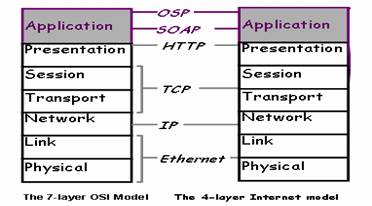|
OSP as an application level protocol in protocol layering
In modern protocol design, protocols are “layered.” Layering is a design principle that divides the protocol design into a number of smaller parts, each of which accomplishes a particular sub-task, and interacts with the other parts of the protocol only in a small number of well-defined ways. For example, one layer might describe how to encode text (with ASCII, say), while another may detect and retry errors (with TCP, the Internet's Transmission control protocol), another handles addressing (with IP, the Internet Protocol). Layering allows the parts of a protocol to be designed and tested without a combinatorial explosion of cases, keeping each design relatively simple.
As illustrated in Figure 1‑6, the reference model usually used for layering is the Open Systems Interconnection (OSI) seven layer model -- physical, link, network, transport, session, presentation, and application layers from bottom to top. The Internet protocols (TCP/IP) can be analyzed using the OSI model, even though TCP/IP has only four distinct layers -- network access (e.g. Ethernet), internet (e.g. IP), transport (e.g. TCP), and application layers (e.g. HTTP). All protocols layered above the HTTP protocol (e.g. SOAP [14], briefly described in the next section) are also called application level protocols. Thus OSP, being a protocol above SOAP, is classified as an application level protocol. As a result, no mechanisms such as encoding and security are addressed in OSP. OSP leverages on the mechanisms provided by its underlying protocols, for example the encoding scheme from SOAP and the security support from HTTP.

|

